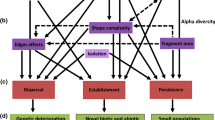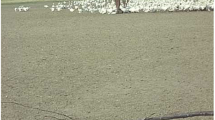Abstract
Due to ubiquitous eutrophication and fragmentation, many plant species are actually threatened in Europe. Most ecosystems face an overall nutrient input leading to changes in species composition. Fragmentation is effectively influencing species survival. We investigate if two different measures of species performance of 91 calcareous grassland species–rate of decline and rarity—are related to comparable traits and hence processes. On the one hand we expected that species rate of decline is mainly determined by the processes of eutrophication and fragmentation. On the other hand we hypothesized that the importance of site characteristics may overwhelm the effect of eutrophication and fragmentation for species rarity. Hence, we compared persistence traits responding to eutrophication, dispersal traits being related to fragmentation and ecological site factors for decreasing and increasing species and for rare and common species. The results suggest that increasing species had better means of long-distance dispersal and were more competitive than decreasing species. In contrast, there were hardly any differences in traits between rare and common species, but site characteristics were related to species rarity. Rare species were in the main those with ecological preferences for warm, dry, light and nutrient poor conditions. This study may represent a basis for the assessment of plant species threat. Applying the deduced knowledge about the life history of decreasing versus increasing species to habitat-scale approaches it is possible to predict which species may become threatened in the future simply from the combination of their trait values.


Similar content being viewed by others
References
Bekker RM, Kwak MM (2005) Life history traits as predictors of plant rarity, with particular reference to hemiparasitic Orobanchaceae. Folia Geobot 2–3:231–242
Bernhardt M (2005) Reaktionen der Waldbodenvegetation auf erhöhte Stickstoffeinträge- Analyse und Vorhersage von Vegetationsveränderungen anhand von funktionellen Merkmalen. Diss Bot 397:1–121
Bernhardt-Römermann M, Kirchner M, Kudernatsch T, Jakobi G, Fischer A (2006) Changed vegetation composition in coniferous forests near to motorways in Southern Germany: the effects of traffic-born pollution. Env Poll 143:572–581
Bobbink R, Hornung M, Roelofs JGM (1998) The effects of air-borne nitrogen pollutants on species diversity in natural and semi-natural European vegetation. J Ecol 86:717–738
Bonn S, Poschlod P (1998) Ausbreitungsbiologie der Pflanzen Mitteleuropas. Quelle and Meyer, UTB, Wiesbaden
Bonn S, Poschlod P, Tackenberg O (2000) “Diasporus”—a database for diaspore dispersal-concept and applications in case studies for risk assessment. ZÖN 9:89–97
Couvreur M, Vandenberghe B, Verheyen K, Hermy M (2004) An experimental assessment of seed adhesivity on animal furs. SSR 14:147–159
Diaz S, Noy-Meir I, Cabido M (2001) Can grazing response of herbaceous plants be predicted from simple vegetative traits? J Appl Ecol 38:497–508
Ehrlén J, Van Groenendal JM (1998) The trade-off between dispersability and longevity—an important aspect of plant species diversity. Appl Veg Sc 1:29–36
Ellenberg H, Weber HE, Düll R, Wirth V, Werner W (2001) Zeigerwerte von Pflanzen in Mitteleuropa. Scripta Geobot 18:1–262
Eriksson A, Eriksson O (1997) Seedling recruitment in semi-natural pastures: the effects of disturbance, seed size, phenology and seed bank. Nord J Bot 17:469–480
Eriksson O, Jakobsson A (1998) Abundance, distribution and life histories of grassland plants: a comparative study of 81 species. J Ecol 86:922–933
Eriksson O, Jakobsson A (1999) Recruitment trade-offs and the evolution of dispersal mechanisms in plants. Evol Ecol 13:411–423
Fiedler PL, Ahouse JJ (1992) Hierarchies of cause: toward an understanding of rarity in vascular plant species. In: Fiedler PL, Jain SK (eds) Conservation biology—the theory and practice of nature conservation, preservation and management. Chapman & Hall, New York, London
Fischer M (1998) Über die Ursache der Gefährdung lokaler Pflanzenpopulationen. Bauhinia 12:9–21
Fischer M, Stöcklin J (1997) Local extinctions of plants in remnants of extensively used calcareous grasslands 1950–1985. Conserv Biol 11:727–737
Fischer SF, Poschlod P, Beinlich B (1996) Experimental studies on the dispersal of plants and animals on sheep in calcareous grasslands. J Appl Ecol 33:1206–1222
Fonseca CR, Overton JM, Collins B, Westoby M (2000) Shifts in trait-combinations along rainfall and phosphorous gradients. J Ecol 88:964–977
Gaudet CL, Keddy PA (1988) A comparative approach to predicting competitive ability from plant traits. Nature 334:242–243
Graae BJ (2002) The role of epizoochorous seed dispersal of forest plant species in a fragmented landscape. SSR 12:113–121
Grime JP (1979) Plant strategies and vegetation processes. Wiley, Chichester, New York, Brisbane, Toronto
Jensen K, Gutekunst K (2003) Effects of litter on establishment of grassland plant species: the role of seed size and successional status. BAE 4:579–587
Kahmen S (2004) Plant trait responses to grassland management and succession. Diss Bot 328:1–122
Kahmen S, Poschlod P (2004) Plant functional trait responses to grassland succession over 25 years. J Veg Sci 15:21–32
Knevel IC, Bekker RM, Bakker JP, Kleyer M (2003) Life-history traits of the Northwest European Flora: the LEDA database. J Veg Sci 14:611–614
Knevel IC, Bekker RM, Kunzmann D, Stadler M, Thompson K (2005) The LEDA traitbase collecting and measuring standards of life-history traits of the Northwest European flora. LEDA Traitbase project online publication. www.leda-traitbase.org. Cited 5 March 2007
Korneck D, Schnittler M, Klingenstein F, Ludwig G, Takla M, Bohn U, May R (1998) Warum verarmt unsere Flora? Auswertung der Roten Liste der Farn- und Blütenpflanzen Deutschlands. Schrreihe Vegkd 29:299–444
Lande R (1998) Anthropogenic, ecological and genetic factors in extinction and conservation. Res Popul Ecol 40:259–269
Lavergne S, Thuiller W, Molina J, Debussche M (2005) Environmental and human factors influencing rare plant local occurrence, extinction and persistence: a 115-year study in the Mediterranean region. J Biogeogr 32:799–811
Lavorel S, Garnier E (2002) Predicting changes in community composition and ecosystem functioning from plant traits: revisiting the Holy Grail. Funct Ecol 16:545–556
Lavorel S, McIntyre S, Grigulis K (1999) Plant response to disturbance in a Mediterranean grassland: how many functional groups? J Veg Sci 10:661–672
Matlack GR (2005) Slow plants in a fast forest: local dispersal as a predictor of species frequencies in a dynamic landscape. J Ecol 93:50–59
McCune B, Mefford MJ (1999) Pc-Ord-multivariate analysis of ecological data. MjM Software, Gleneden Beach
McIntyre S, Diaz S, Lavorel S, Cramer W (1999) Plant functional types and disturbance dynamics—introduction. J Veg Sci 10:604–608
Moles AT, Westoby M (2004) Seedling survival and seed size: a synthesis of the literature. J Ecol 92:372–383
Oberdorfer E (1978) Süddeutsche Pflanzengesellschaften. Gustav Fischer Verlag, Stuttgart
Olesen JM, Jain SK (1994) Fragmented plant populations and their lost interactions. In: Loeschke V, Tomiuk J, Jain SK (eds) Conservation Genetics. Birkhäuser Verlag, Basel
Pakeman RJ (2004) Consistency of plant species and trait responses to grazing along a productivity gradient: a multi-site analysis. J Ecol 92:893–905
Poschlod P, Bonn S (1998) Changing dispersal processes in central European landscape since the last ice age: an explanation for the actual decrease of plant species richness in different habitats? Acta Bot Neerl 47:27–44
Poschlod P, WallisDeVries MF (2002) The historical and socioeconomic perspective of calcareous grasslands-lessons from the distant and recent past. Biol Conserv 104:361–376
Poschlod P, Kiefer S, Tränkle U, Fischer S, Bonn S (1998) Plant species richness in calcareous grasslands as affected by dispersability in space and time. Appl Veg Sci 1:75–90
Poschlod P, Kleyer M, Tackenberg O (2000) Databases on life history traits as a tool for risk assessment in plant species. ZÖN 9:3–18
Poschlod P, Kleyer M, Jackel AK, Dannemann A, Tackenberg O (2003) BIOPOP—a database of plant traits and internet application for nature conservation. Folia Geobot Phytotaxon 38:263–271
Poschlod P, Tackenberg O, Bonn S (2004). Plant dispersal potential and its relation to species frequency and coexistence. In: van der Maarel E (ed) Vegetation Ecology. Blackwell, London
Pywell RF, Bullock JM, Roy DB, Warman L, Walker KJ, Rothery P (2003) Plant traits as predictors of performance in ecological restoration. J Appl Ecol 40:65–77
Rabinowitz D (1981) Seven forms of rarity. In: Synge H (ed) The biological aspects of rare plant conservation. Wiley, Chichester
Ringler A (1995) Einführung-Ziele der Landschaftspflege in Bayern. Bayerisches Staatsministerium für Landesentwicklung und Umweltfragen und Bayerische Akademie für Naturschutz und Landschaftspflege, München
Römermann C (2006) Patterns and processes of plant species frequency and life-history traits. Dissertation Botanicae 402, 117p
Römermann C, Tackenberg O, Poschlod P (2005a) How to predict attachment potential of seeds to sheep and cattle coat from simple morphological seed traits. Oikos 110:219–30
Römermann C, Tackenberg O, Poschlod P (2005b) Dispersability traits. In: Knevel K, Bekker RK, Kurtmann D, Stadler M, Thompson K (eds) The LEDA traitbase collecting and measuring standards of life-history traits of the North West European flora. http://www.leda-traitbase.org
Römermann C, Tackenberg O, Scheuerer M, May R, Poschlod P (2007) Predicting habitat distribution and frequency from plant species co-occurrence data. J Biogeogr 34:1041–1052
Saunders DA, Hobbs RJ, Margules CR (1991) Biological consequences of ecosystem fragmentation: a review. Conserv Biol 5:18–32
Smart SM, Bunce RGH, Marrs R, LeDuc M, Firbank LG, Maskell LC, Scott WA, Thompson K, Walker KJ (2005) Large-scale changes in the abundance of common higher plant species across Britain between 1978, 1990 and 1998 as a consequence of human activity: Tests of hypothesised changes in trait representation. Biol Conserv 124:355–371
Tackenberg O, Römermann C, Poschlod P, Thompson K (2006) What does diaspore morphology tell us about external animal dispersal? Evidence from standardized experiments measuring seed retention on animal coats. BAE 7:45–58
Thompson K (1994) Predicting the fate of temperate species in response to human disturbance and global change. In: Boyle TJB, Boyle CEB (eds) Biodiversity, temperate ecosystems and global change. Springer, Berlin
Walker KJ, Preston CD (2006) Ecological predictors of extinction risk in the flora of lowland England, UK. Biodivers Conserv 15:1913–1942
Welk E (2002) Arealkundliche Analyse und Bewertung der Schutzrelevanz seltener und gefährdeter Gefäßpflanzen Deutschlands. Schrreihe Vegkd 37:1–337
Weller SG (1994) The relationship of rarity to plant reproductive biology. In: Bowles ML, Whelan CJ (ed) Restoration of endangered species: conceptual issues, planning, and implementation. Cambridge University Press, Chicago
Westoby M (1998) A leaf-height-seed LHS. Plant ecology strategy scheme. Plant Soil 199:213–227
Westoby M, Falster DS, Moles AT, Vesk PA, Wright IJ (2002) Plant ecological strategies: some leading dimensions of variation between species. Annu Rev Ecol Syst 33:125–159
Willems JH, Peet RK, Bik L (1993) Changes in chalk-grassland structure and species richness resulting from selective nutrient additions. J Veg Sci 4:203–212
Williams NSG, Morgan JW, McDonnell MJ, McCarthy MA (2005) Plant traits and local extinctions in natural grasslands along an urban-rural gradient. J Ecol 93:1203–1213
Willson MF (1993) Dispersal mode, seed shadows, and colonization patterns. Vegetatio 107/108:261–280
Wright IJ, Westoby M (1999) Differences in seedling growth behaviour among species: trait correlations across species, and trait shifts along nutrient compared to rainfall gradients. J Ecol 87:85–97
Acknowledgements
We would like to acknowledge all members and contributors of the LEDA-traitbase (www.leda-traitbase.org) for providing species trait data, especially J. Klimešová (data on clonal species) and D. Kunzmann (data on SLA). We thank all contributors of the floristic mapping of Germany and the German Phytodiversity Network (NetPhyD) for providing species distribution data. M. Bernhardt-Römermann gave useful comments on the manuscript. Research was supported by the European Commission (LEDA-project, EVR1-CT-2002-40022).
Author information
Authors and Affiliations
Corresponding author
Electronic supplementary material
Below is the link to the electronic supplementary material.
Rights and permissions
About this article
Cite this article
Römermann, C., Tackenberg, O., Jackel, AK. et al. Eutrophication and fragmentation are related to species’ rate of decline but not to species rarity: results from a functional approach. Biodivers Conserv 17, 591–604 (2008). https://doi.org/10.1007/s10531-007-9283-2
Received:
Accepted:
Published:
Issue Date:
DOI: https://doi.org/10.1007/s10531-007-9283-2




